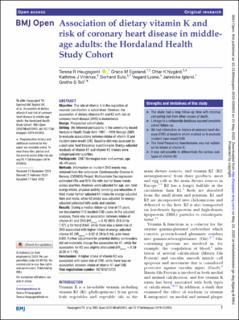| dc.contributor.author | Haugsgjerd, Teresa Risan | |
| dc.contributor.author | Egeland, Grace M. | |
| dc.contributor.author | Nygård, Ottar | |
| dc.contributor.author | Vinknes, Kathrine | |
| dc.contributor.author | Sulo, Gerhard | |
| dc.contributor.author | Lysne, Vegard | |
| dc.contributor.author | Igland, Jannicke | |
| dc.contributor.author | Tell, Grethe S. | |
| dc.date.accessioned | 2021-02-17T08:05:11Z | |
| dc.date.available | 2021-02-17T08:05:11Z | |
| dc.date.created | 2020-09-11T10:41:47Z | |
| dc.date.issued | 2020 | |
| dc.Published | BMJ Open. 2020, 10 . | |
| dc.identifier.issn | 2044-6055 | |
| dc.identifier.uri | https://hdl.handle.net/11250/2728569 | |
| dc.description.abstract | Objective: The role of vitamin K in the regulation of vascular calcification is established. However, the association of dietary vitamins K1 and K2 with risk of coronary heart disease (CHD) is inconclusive.
Design: Prospective cohort study.
Setting: We followed participants in the community-based Hordaland Health Study from 1997 - 1999 through 2009 to evaluate associations between intake of vitamin K and incident (new onset) CHD. Baseline diet was assessed by a past-year food frequency questionnaire. Energy-adjusted residuals of vitamin K1 and vitamin K2 intakes were categorised into quartiles.
Participants: 2987 Norwegian men and women, age 46–49 years.
Methods: Information on incident CHD events was obtained from the nationwide Cardiovascular Disease in Norway (CVDNOR) Project. Multivariable Cox regression estimated HRs and 95% CIs with test for linear trends across quartiles. Analyses were adjusted for age, sex, total energy intake, physical activity, smoking and education. A third model further adjusted K1 intake for energy-adjusted fibre and folate, while K2 intake was adjusted for energy-adjusted saturated fatty acids and calcium.
Results: During a median follow-up time of 11 years, we documented 112 incident CHD cases. In the adjusted analyses, there was no association between intake of vitamin K1 and CHD (HRQ4vsQ1 = 0.92 (95% CI 0.54 to 1.57), p for trend 0.64), while there was a lower risk of CHD associated with higher intake of energy-adjusted vitamin K2 (HRQ4vsQ1 = 0.52 (0.29 to 0.94), p for trend 0.03). Further adjustment for potential dietary confounders did not materially change the association for K1, while the association for K2 was slightly attenuated (HRQ4vsQ1 = 0.58 (0.28 to 1.19)).
Conclusions: A higher intake of vitamin K2 was associated with lower risk of CHD, while there was no association between intake of vitamin K1 and CHD. | en_US |
| dc.language.iso | eng | en_US |
| dc.publisher | BMJ Publishing Group | en_US |
| dc.rights | Navngivelse-Ikkekommersiell 4.0 Internasjonal | * |
| dc.rights | Navngivelse-Ikkekommersiell 4.0 Internasjonal | * |
| dc.rights.uri | http://creativecommons.org/licenses/by-nc/4.0/deed.no | * |
| dc.title | Association of dietary vitamin K and risk of coronary heart disease in middle-age adults: the Hordaland Health Study Cohort | en_US |
| dc.type | Journal article | en_US |
| dc.type | Peer reviewed | en_US |
| dc.description.version | publishedVersion | en_US |
| dc.rights.holder | Copyright Author(s) (or their employer(s)) 2020. | en_US |
| dc.source.articlenumber | e035953 | en_US |
| cristin.ispublished | true | |
| cristin.fulltext | original | |
| cristin.qualitycode | 1 | |
| dc.identifier.doi | 10.1136/bmjopen-2019-035953 | |
| dc.identifier.cristin | 1828996 | |
| dc.source.journal | BMJ Open | en_US |
| dc.source.40 | 10 | |
| dc.identifier.citation | BMJ Open. 2020, 10 (5), e035953. | en_US |
| dc.source.volume | 10 | en_US |
| dc.source.issue | 5 | en_US |

